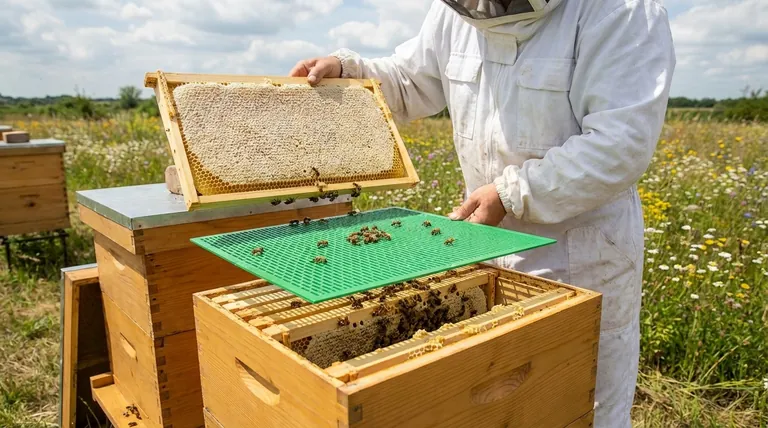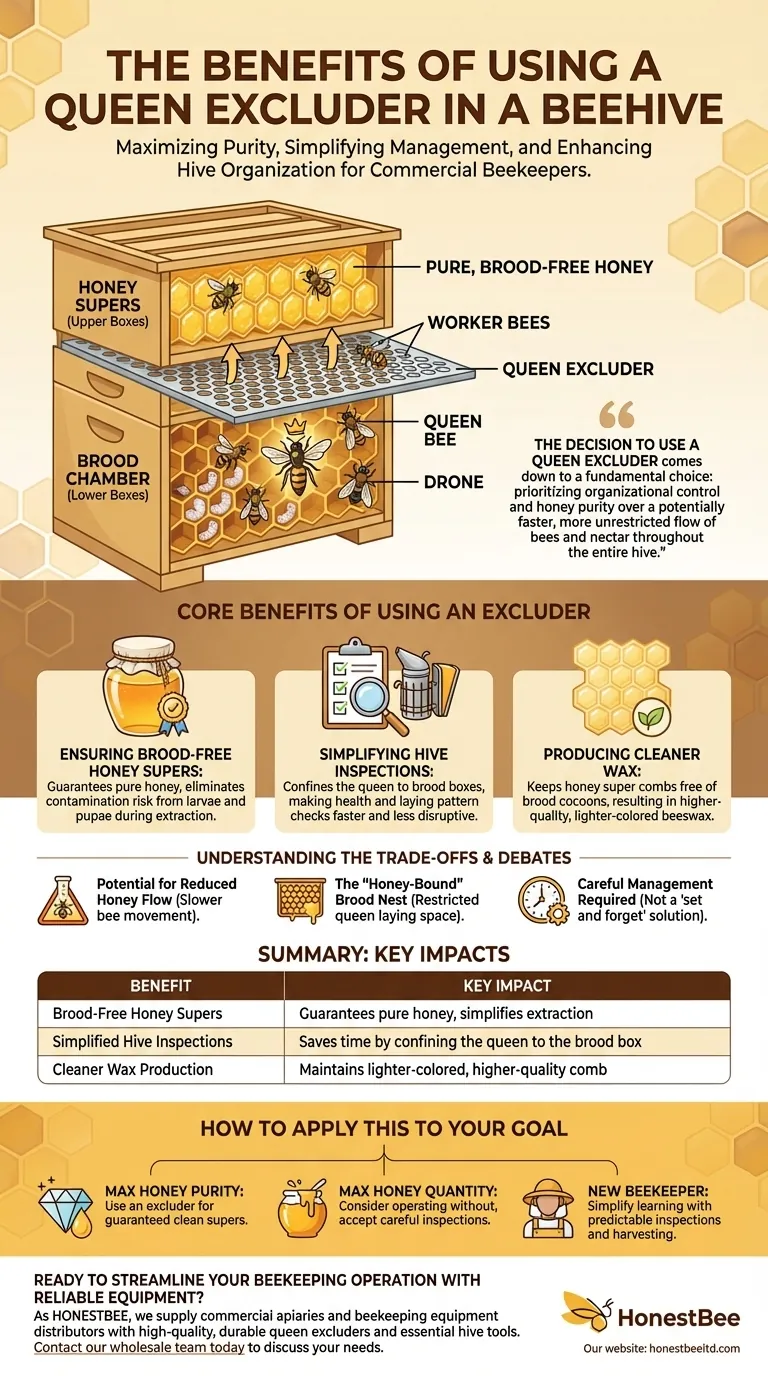A queen excluder’s primary benefit is to create a physical barrier that keeps the larger queen bee confined to the hive's brood chambers. This prevents her from laying eggs in the honey supers, which ensures the honey you harvest is pure, clean, and free of developing bees, simplifying both hive management and the extraction process.
The decision to use a queen excluder comes down to a fundamental choice: prioritizing organizational control and honey purity over a potentially faster, more unrestricted flow of bees and nectar throughout the entire hive.

What is a Queen Excluder and How Does It Work?
A queen excluder is a simple but highly effective tool for hive organization. Understanding its basic principle is key to using it effectively.
The Principle of Selective Access
The excluder is a flat screen, typically made of metal or plastic, with precisely sized openings.
These openings are large enough for the smaller worker bees to pass through freely.
However, the holes are too small for the larger bodies of the queen and male drones, effectively blocking them from moving into other sections of the hive.
Strategic Placement within the Hive
The excluder is placed between the brood chamber (the lower boxes where the queen lays eggs and raises young bees) and the honey supers (the upper boxes intended solely for honey storage).
This placement creates a clear division in the hive: brood rearing happens below the excluder, and clean honey storage happens above it.
The Core Benefits of Using an Excluder
Using an excluder provides beekeepers with distinct advantages that directly impact honey quality and operational efficiency.
Ensuring Brood-Free Honey Supers
The single most important benefit is the guarantee of brood-free honey.
When the queen lays eggs in honey combs, the resulting larvae and pupae can contaminate the final product during extraction. An excluder eliminates this risk entirely.
This makes the uncapping and extraction process faster and cleaner, as you don't have to meticulously check every frame for the presence of brood.
Simplifying Hive Inspections
Knowing the queen is confined to the brood box dramatically speeds up hive management.
Instead of searching through the entire hive to assess her health and laying pattern, you can focus your inspection on the boxes below the excluder. This saves time and reduces disruption to the colony.
Producing Cleaner Wax
Combs that are used exclusively for honey storage remain cleaner and lighter in color over time.
Brood combs darken as they are used, accumulating cocoons and other materials. By keeping the supers separate, you can harvest higher-quality, cleaner beeswax when you eventually cycle out old honey frames.
Understanding the Trade-offs and Debates
While beneficial, queen excluders are a subject of debate among beekeepers. It is critical to understand the potential downsides.
Potential for Reduced Honey Flow
The most common argument against excluders is that they can slow down worker bees.
Forcing thousands of bees through a barrier may create a "bottleneck" that reduces the efficiency of honey storage, potentially leading to a smaller harvest. Some bees may be hesitant to cross the barrier, especially if it's not installed perfectly.
The "Honey-Bound" Brood Nest
If bees are reluctant to move up through the excluder, they may begin storing excess nectar in the brood chamber instead.
This can fill cells the queen needs for laying eggs, a condition known as being honey-bound. This restricts colony growth and can increase the likelihood of the colony deciding to swarm.
Careful Management is Required
Using an excluder isn't a "set it and forget it" solution.
A beekeeper who confines the queen must be diligent about ensuring she has enough space to lay in the brood boxes. Failure to add more brood space as the colony grows is a primary trigger for swarming.
How to Apply This to Your Goal
The decision to use a queen excluder should be based on your specific beekeeping objectives and management style.
- If your primary focus is maximum honey purity and simple harvesting: An excluder is an invaluable tool for guaranteeing clean, brood-free honey supers.
- If your primary focus is maximizing honey quantity with minimal hive interference: You might operate without an excluder, accepting the need to carefully inspect honey frames for brood before extraction.
- If you are a new beekeeper: Using an excluder can significantly simplify the learning process by making hive inspections and honey harvesting much more predictable.
Ultimately, the queen excluder is a strategic tool that offers control and organization in exchange for more attentive management of your hive's space.
Summary Table:
| Benefit | Key Impact |
|---|---|
| Brood-Free Honey Supers | Guarantees pure honey, simplifies extraction |
| Simplified Hive Inspections | Saves time by confining the queen to the brood box |
| Cleaner Wax Production | Maintains lighter-colored, higher-quality comb |
Ready to streamline your beekeeping operation with reliable equipment?
As HONESTBEE, we supply commercial apiaries and beekeeping equipment distributors with high-quality, durable queen excluders and other essential hive tools through our wholesale-focused operations. Our products are designed to help you achieve the organizational control and honey purity discussed in this article.
Contact our wholesale team today to discuss your needs and discover how our supplies can benefit your business.
Visual Guide

Related Products
- High Performance Plastic Queen Excluder for Beekeeping and Apiary Management
- Professional Plastic Queen Excluder for Modern Beekeeping
- Wooden Queen Bee Excluder for Beekeeping
- Premium Wood Framed Metal Wire Queen Bee Excluder
- Plastic Queen Bee Excluder for Bee Hive Wholesale
People Also Ask
- What impact does a queen excluder have on colony defensiveness? Control Hive Temperament for Safer Beekeeping
- How does a queen excluder affect honey storage? Maximize Clean Honey Yields in Your Hive
- What is a queen excluder, and how does it function? A Guide to Hive Management
- When is the typical time frame for harvesting honey and removing the queen excluder? Optimize Your Hive Management
- What happens if I don't use a queen excluder? Understand the impact on your honey harvest.



















